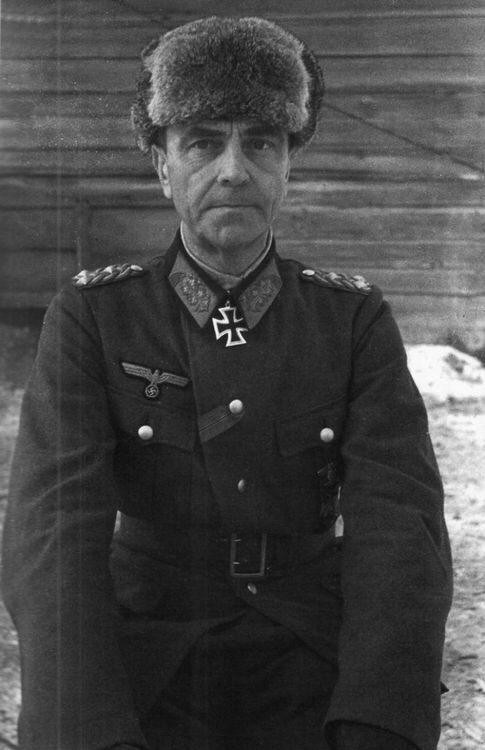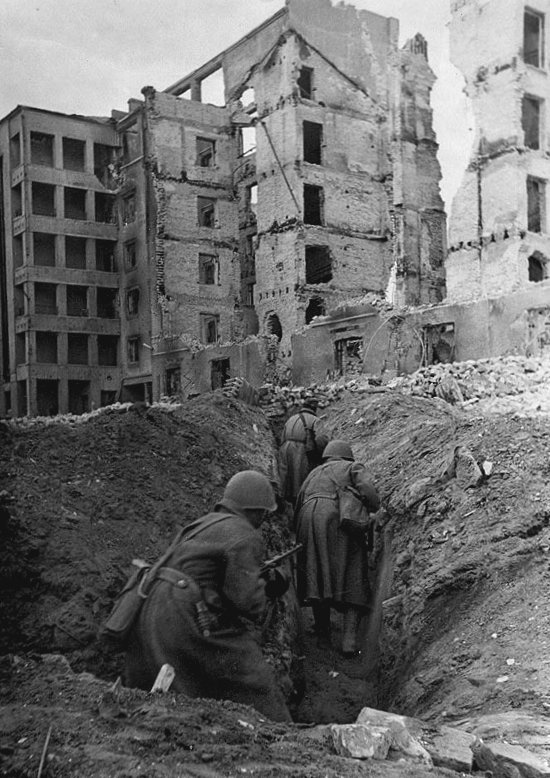 |
| Soviet soldier waving the Red Banner over the central plaza of Stalingrad in 1943 |
The Battle of Stalingrad was one of the decisive battles of World War II. Lasting from August 1942 to February 1943, the battle pitted the forces of the Soviet Union against those of Nazi Germany amid the ruins of the city of Stalingrad. Soviet victory in February 1943 proved a major Allied triumph and a turning point of the war.
On June 28, 1942, the German High Command launched Operation Blau (blue) against the Soviet Union. Blau's objectives were to capture the oil fields and agricultural resources of the Caucasus region and the city of Stalingrad.
This task was assigned to Army Group South, a coalition of German, Italian, Romanian, and Hungarian armies. Army Group South advanced through heavy Soviet resistance throughout the summer of 1942 and by August had reached Stalingrad.
  |
German forces unleashed a devastating bombardment against Stalingrad and reduced much of the city to rubble. As German infantry units entered the city, Soviet forces and even Stalingrad's citizens fiercely resisted.
Seemingly endless street-to-street and house-to-house combat resulted in heavy casualties on both sides. Snipers hid amid the ruins and inflicted numerous casualties, with both Russian and German snipers earning renown for their marksmanship and lethality.
 |
| German Ju 87 ‘Stuka’ dive bomber over Stalingrad |
The Soviet commander charged with the defense of Stalingrad was Vasily Chuikov. Chuikov had strict orders from Joseph Stalin to hold the city at any cost; indeed, Stalin had issued similar instructions to all Soviet soldiers in the famous Order No. 227 forbidding retreat.
Particular Stalingrad landmarks were fought over continuously, such as the Red October factories, "Pavlov's House," and a large hill overlooking the city, the Mamayev Kurgan. Although Soviet forces tenaciously defended these sites, by November German forces held 90 percent of Stalingrad.
While Stalingrad's defenders held fast, the Soviet High Command launched a counterattack, Operation Uranus. Uranus called for an assault on the northern and southern flanks of Army Group South. The Soviets deemed these flanks particularly vulnerable because ill-equipped and unenthusiastic Romanian units guarded them. On November 19 Soviet forces assaulted the Third Romanian Army in the north.
 |
| German soldier with a machine gun during the Battle of Stalingrad |
The following day Soviets attacked the Romanian 4th Army Corps in the south. The Romanians quickly gave way, allowing Soviet armies from both flanks to meet at the town of Kalach and successfully execute a pincer movement that encircled 250,000 Axis soldiers within the Stalingrad sector.
The German commander of Axis forces within Stalingrad, Sixth Army's general Friedrich Paulus, sought permission to fight through the encirclement and escape. Hitler refused, assuring Paulus that German relief would soon break the siege.
Hermann Göring pledged that his Luftwaffe could supply Stalingrad via an "air bridge," delivering over 300 tons of food, fuel, and ammunition daily. His boasts, however, were wildly exaggerated and only a trickle of the supplies arrived.
 |
| Sixth Army's general Friedrich Paulus |
The bitter Russian winter, dwindling supplies, and constant fighting severely reduced Axis resistance in Stalingrad. Soviet troops inexorably inched forward, pushing the Germans back to the city center.
Paulus was captured by Soviet forces on January 31, along with 22 other German generals. Axis forces finally surrendered on February 2. Soviet forces captured over 90,000 German soldiers; only 6,000 would survive the war and return home.
 |
| Russian soldiers advancing through trenches |
Germany's defeat at Stalingrad proved the turning point of the war. Germany's reputation for invincibility was shattered, and after Stalingrad the Germans endured a defensive position on the eastern front.
The Soviets gained an important strategic and psychological triumph and pushed steadily toward Berlin. Soviet victory came at great sacrifice, however; the Battle of Stalingrad is considered World War II's bloodiest battle, with over 2 million deaths on both sides.
 |
| German soldiers surrender at Stalingrad in February 1943 |